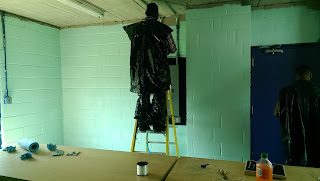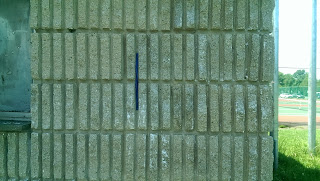Accomplishments:
- Completed the French Drain. (Pictures of progress will be posted soon)
Today at 12:00pm in room S315, we will have a powerpoint presentation about the Blockhouse Project.
Goal:
The French Drain
Our first major issue upon entering the blockhouse was not the dust or spiderwebs, but the flood that had formed every time it rained. The rainwater leaked from beneath the garage door and the base of the walls, making it nearly impossible to do productive work within the building. In fact, one of the very first actions taken by our predecessors were to replace the roof because water was leaking from above as shown in the following picture:
Notice the shaded area on the wall, trailing from the roof and narrowing at the floor.
As a follow up, STEM 2015 has been working on a drain in front of the garage door to channel the rainwater through PVC pipes and into a sewer basin.
Chisel and hammer were used to remove the asphalt and old concrete. A shovel was used to dig out the gravel and dirt until we reached about 8'' below ground-level. After this, we created a new base of concrete to support the drainage and seal it in place.

A drill was rented from McManus Rentals by our supervisors Professor Joe Sivo and Luis De Abreu. It was used to create a hole through the sewer basin so we may feed the end of a PVC pipe through it.
 |
| Luis drilling through basin sewer. |
Hydraulic Cement was used to seal the base of the outside wall by the garage door and the area around the PVC pipe when fed through the sewer to keep it in place. We mixed the hydraulic cement with water at a 3:1 ratio until we obtained a pasty mixture. It's almost like playing with clay, except it hardens in approximately a minute after mixed with water. Our team had to work fast and diligently, making sure we didn't leave indentation or fingerprints on the finished product.
 |
| Luis applying primer to the pipe joints |

In the left,
Luis De Abreu slathers primer (the purple liquid) at the joints of the pipes, which prevents any contaminants from interfering with the bonding of the pipes when the
Oatey primer cement (the cream container below) is applied to keep them joined.
 |
| Oatey Cement to the left and Primer to the right. |
Holes were drilled onto the last pipe leading into the sewer basin and covered by a filter sock (the black fabric) and then buried under gravel. This is calle
d a french drain. The idea is that rain water will sink through the gravel and enter the pipe while keeping out dirt and debris.
 |
| Pipe with Filter Sock |
 |
| Pipe with holes |
 |
| Filter Sock |
At last, the french drain is complete and most of the water flooding into the building has been eliminated; however, more hydraulic cement is to be added at the base of the blockhouse interior walls.
 |
| End of pipe leading into sewer basin and sealed with hydraulic cement. |
 |
| Complete French Drain |

















































